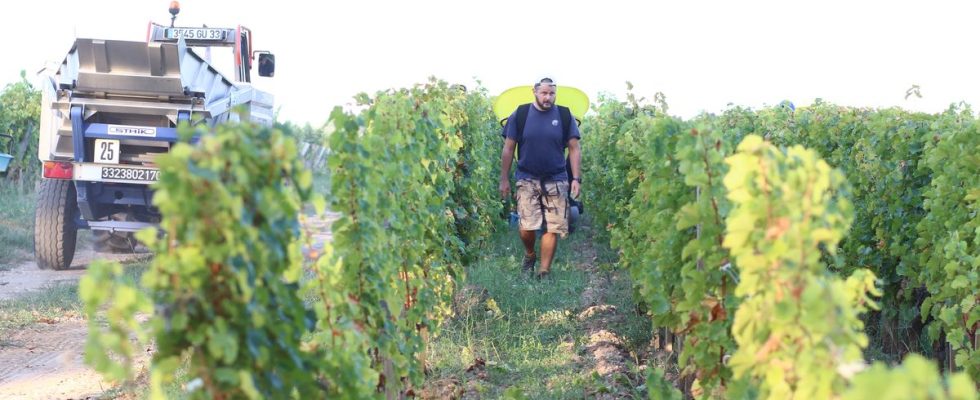This Thursday morning, caps, hats and scarves were required for the majority of the sixty or so pickers present in the vineyard of Château Carbonnieux, which kicked off its harvest for the whites (Sauvignon Blanc and Sémillon). This Grand Cru Classé in the Graves-Pessac Léognan appellation extends over a hundred hectares south of Bordeaux, half white and half red.
Temperatures did not drop below 24°C overnight, and at 7 a.m., the thermometer was already showing 26°C. “We would have liked to start earlier, but it’s not day yet,” explains Freddy, the crop manager. “These temperatures in the morning are unheard of,” a picker told us. We are used to working in very hot weather, but usually in the morning at least it’s cool, whereas here we have to start with 25-26°C already! »
Noémie, who has been harvesting for three years on this estate, explains that “with the water tank made available to us, we will be able to water ourselves regularly to bring down the temperature, and above all we have to drink a lot. “Cover up and rest” is also essential, underlines one of her colleagues.
Cool grapes that are too hot
“You have to ensure the comfort of the staff, continues the crop manager, because the harvest will last six to seven weeks. This is why we take breaks, and we stop around 11:30 am to 12 noon, to preserve the organisms. » Organisms, and the Grape. Because it is also necessary to “ensure the quality of the harvest” adds the head of culture. “This episode of heat wave will have negative consequences on some grapes, because it is brief, sudden, and the plant has not been used to this type of climate this year, which has been rather rainy” worries Andreas Perrin, the cellar master.
“This heat wave is not good for humans or for the vineyard,” confirms Eric Perrin, co-owner of the château. “We can’t pick the harvest too hot, even if we have what it takes to cool the grapes in the cellar,” adds the vineyard manager. However, “this morning, the grapes that we enter the cellar are already at the temperature that they usually reach in the middle of the day for the end of August”, analyzes his son, Andreas Perrin, master of cellar. Consequence: instead of putting them directly in the press, “we will have to cool them with refrigeration mechanisms, which we do every year, but not in the morning, and not necessarily with as much power. This will therefore represent additional energy consumption. »
The cooling of the harvest is necessary for “the pressing process, which is the key stage for white winemaking”, explains Andreas Perrin. “Beyond 20°C, there may be fermentation starts, and chemical mechanisms may be activated, which may lead to loss of aroma. »
Fear of aroma loss
The loss of aroma is one of the fears at Château Carbonnieux for such an early harvest. “When we pick in mid-August, we have to be much more vigilant and take care not to arrive in a situation of over-maturity, explains Eric Perrin. We are especially afraid, by this heat wave, to experience phenomena of drops in acidity and combustion of aromas, while we must preserve freshness, fruit and acidity in our harvests. »

A situation that has reversed compared to the years 1970-1980. “At that time, it was more complex to bring the grapes to maturity, especially Cabernet, remembers Eric Perrin, we were then authorized to chaptalize, that is to say add sugar to raise the alcohol level , which brought the complement of what the sun had not given. »
“August is becoming the norm for the start of the harvest”
What has changed in the meantime is the rise in temperatures and the date of the start of the harvest, which has inexorably moved forward. “The harvest usually always started after September 15 for the whites,” continues the co-owner of the estate. In the 1990s, we started having harvests in early September, then there was a change with the heat wave of 2003, when we ended up with harvests in mid-August. And behind, it went on. »
“The month of August is becoming the norm, confirms Andreas Perrin, but with such heat it is unheard of, even if it had been hot longer in 2022. Little by little, we are experiencing the same climatic conditions as in Languedoc-Roussillon, where the harvest starts at the beginning of August and is sometimes done at night. »
In recent years, “we have experienced a more Mediterranean climate” also recognizes Eric Perrin. “Will tomorrow we have Mediterranean grape varieties, why not? The question of modifying our production rules, with the hydration of our vineyards, also arises. We have entered an environmental era. »
A promising harvest
The organic issue is also on the table. “A third of the property is organic, and the question of converting the entire property obviously arises, admits Eric Perin. Even though this cultivation system is not always effective in protecting our vineyards against diseases, especially when we experience alternations, like this year, of rain, heat and tropical climate, which are nests development for fungi. The year 2023 was also marked by a strong spread of mildew in the Bordeaux vineyards.
Château Carbonnieux was relatively spared from this disease, since the deficit in production volume is estimated at around 3% only. “We did what was necessary, we were always on the lookout, explains the crop manager. It was an intense year because the vines grew very quickly, and we had to be very reactive behind it. But today, the harvest looks very promising. »

